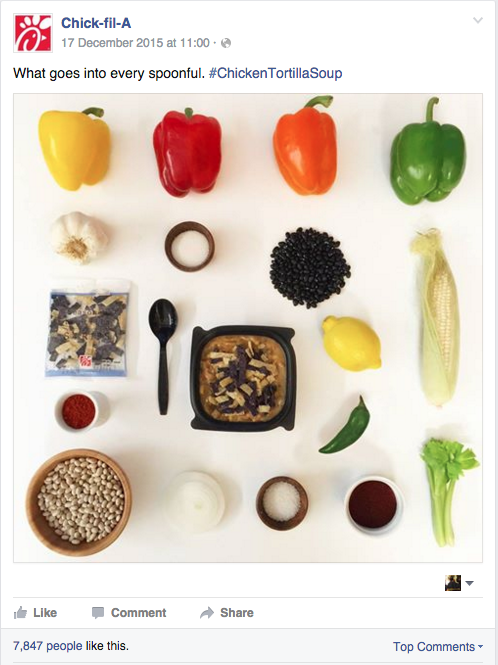Chick-fil-A uses data to respond to 35,000 social media mentions a month

Chick-fil-A is quickening its pulse in social, using a mix of data mining and loose rules of engagement to respond to 35,000 social media mentions a month and create content in under two or three minutes in most cases.
The fast-food brand was the first client at Unit3C, a production and content studio started by its agency, Moxie. Moxie opened the 700-square-foot studio in Atlanta because it needed strategy, production, creative and media together under one roof to get content, especially for social, out faster. While Chick-fil-A’s social interactions have only increased by about 10 percent in the past year, the brand contends the quality of content has improved. And today, the brand is able to produce a post and photo in under two or three minutes.
“The one thing we’ve realized today is that as a brand, we have a very short runway to get into any conversation,” said Kristen Hunter, who heads social and digital marketing for Chick-fil-A. “So if we want to be relevant with our content, we also have to respond to as much as possible, and do it quickly.”
One way it does that is by tailoring its approach on platforms. On Facebook, where the brand has 7.5 million followers, the audience is heavily “mom,” said Erik Hostelter, who heads Unit3C. So content focuses on recipes that would appeal to older females, while the team responds to questions about availability and nutrition. Hunter said that her focus is on shortening approval times so they can respond to questions and post new content faster.

Facebook is still the brand’s largest platform, but it has largely shifted to a paid one. Chick-fil-A’s fastest growing one is now Instagram.
On Instagram, where the company has 335,000 followers, the brand’s approach is designed for the platform’s younger users. Most of the photos are actual pictures of food. Photos are taken on an iPhone, and the food is never retouched beyond a filter.
“We can do that because our food looks good,” said Hostelter.
But it’s not just sandwiches, artfully arranged: Every photo tries to have a “human” element — whether it’s a hand reaching out for a milkshake or a burger on a typical kitchen table. “Everything has to look like it’s just about to be consumed,” said Hostetler.
To make shoots happen quickly, they take place wherever is needed: at Hostetler’s house, because he has a pool, or in someone else’s garden. For last year’s college football game between the University of Georgia and the University of Florida, the brand wanted to promote its “catering” option using Twitter Amplify.
So in a week’s time, Chick-fil-A and Moxie created 10 six-second spots, all shot at an account director’s house. One featured a Florida fan cheering with his mouth full of chicken that could be deployed if Florida scored, and so on. At the Chick-fil-A of a year ago, that probably wouldn’t have been possible considering the layers of approval needed. Now, because legal and production sit together, it is.
And it’s had success: Engagement Labs, a firm that crunches social data, named it America’s top brand on social media for 2015 across Facebook, Twitter and Instagram — topping Netflix and Amazon. Next year, said Hunter, the focus is on figuring out how to be agile while producing posts that anticipate real-time moments on social rather than just reacting to them.
But social media for Chick-fil-A also involves plenty of firefighting. Over the last few years, the COO’s anti-gay comments and the brand’s support of anti-LGBT causes have drawn fire. While the donations have ceased and the brand has largely distanced itself from those comments, the conservative stance remains. It’s still closed on Sundays, for example.
Its social media team has taken something of a middle ground on these issues; it doesn’t delete comments on its accounts, nor does it respond to each one. “Yes, we’re conservative,” said Hostetler. “But we’re also real. We can be both.”
More in Marketing

With the rise of the chief AI officer, it’s time to examine ‘czar’ culture
Even if it’s a familiar pattern — hot new thing, new C-Suite exec to tackle said thing, a few years go by and that C-Suite position no longer exists as everyone is now doing said thing (or it was a fad that has since faded away) — does it make sense for businesses to continue to appoint new czars with every new trend?

Why Cava’s bid for brand awareness means prioritizing streaming ads
Fast-casual restaurant chain Cava has been in growth mode over the past year and is leaning into streaming ads in an effort to boost brand awareness.

A history of middle manager stress: The Return podcast, season 3, episode 1
In episode one, McKinsey partner Emily Field tells us more about why middle management is critically important to the workforce.





